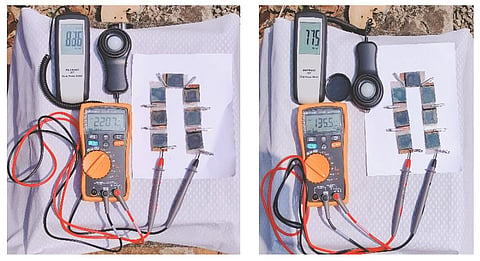

THIRUVANANTHAPURAM: A solar cell that works with the same efficiency even when the sun remains hidden behind clouds for many days - That's what researchers from the University of Kerala have come up with. They are now working on further increasing the efficiency of the solar cell that generates power from ultraviolet (UV) light.
The 'visible blind solar cell', named so for its insensitivity to visible and infrared light but responds to ultraviolet light, is lead-free and uses oxides of zinc and copper that are non-hazardous. Both of them are earth-abundant materials and could help deliver economically viable as well as environmentally benign alternatives to the current solar cells.
The research team, led by R Jayakrishnan, Associate Professor, Department of Physics, University of Kerala, comprised Akhil M. Anand, Aruna Raj, R. Adithya Nath and Jishad A Salam. The innovative technology behind the cell appeared in the peer-reviewed International Journal of Materials Science recently,
"We are currently engaged in efforts to make the visible blind solar cell a commercially viable product. For that we need to increase the present efficiency of 4.5 % to above 10 %," said Jayakrishnan. Presently, solar cells are opaque and do not let in light through them. "The visible blind solar cell, on the other hand, works as a transparent medium that lets in the light, paving the way for its use in any surface that needs light to pass through such as a window or a pergola," he added.
While the commercially available silicon-based photovoltaic cells have higher efficiency of 18 - 20%, the cost is high. Also, the use of hazardous materials such as lead has triggered increased demands for not only eco-friendly but also cost-effective solar cells. According to Jayakrishnan, while a single conventional silicon solar cell would cost around Rs 2,800, a similar-sized UV solar cell can be produced with just under Rs 300.
The development of transparent optoelectronics has a wide range of potentially useful applications involving displays, solar cells, sensors and batteries. Also, UV photodetectors have immense applications elsewhere as well. "Take for instance its use in industries where people are exposed to harmful radiation or UV rays. The technology behind the cells can be used as a UV detector and help those exposed to them adopt protective measures," he said.